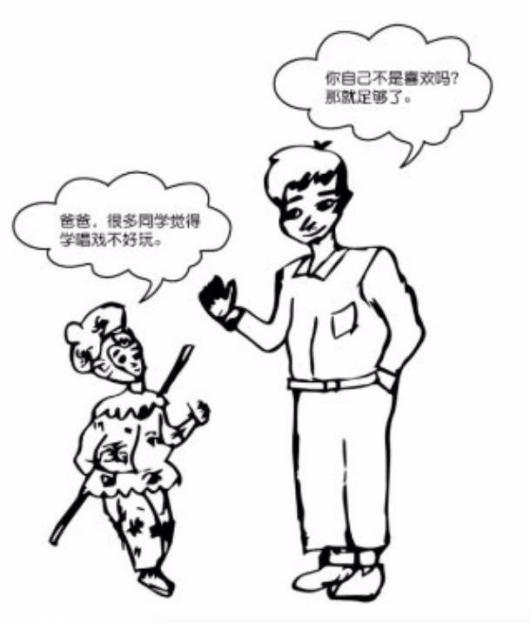

In the picture,a boy in the Monkey King costume tells his father that many of his classmates find it boring to learn traditional Chinese opera."Aren't you yourself fond of it?That is all that matters,"his father replies in a tone of encouragement.
The picture is aimed at inspiring us to chase our passions and dreams regardless of what others may say.The original purpose of pursuing a hobby or a dream is by no means to please others, but to lead ourselves to a more fulfilling and meaningful life.It is thus totally unnecessary for us to hesitate to do what we enjoy for fear of disapproval from others.Admittedly, remaining open to constructive advice is conducive to our growth and future success.But we will never be able to take charge of our own destiny if we are easily swayed by throwaway or even biased remarks of others.
To sum up, having a distinctive hobby is nothing to be ashamed of.Different strokes for different folks, after all.Instead of giving in to pressure to follow the herd, we should be determined and courageous to stick to what we feel enthusiastic about.
扫描微信二维码,添加您的专属老师为好友
您在考试中遇到任何问题,老师都会帮您解答

您希望我们通过哪种方式与您联系?
 电话
电话
 微信
微信
 QQ
QQ
 电话
电话
 微信
微信
 QQ
QQ
 不联系
不联系
您已选择电话/微信/QQ的联系方式,课程顾问会尽快联系您!
您已选择微信联系方式,课程顾问会尽快添加您的微信,请您确认通过!
您已选择QQ联系方式,课程顾问会尽快添加您的QQ,请您确认通过!
您已选择电话联系方式,课程顾问会尽快联系您!
您已选择“不联系”,课程顾问不会主动联系您。
如果后续您有需求,可以在个人中心主动添加销售微信或拨打客服电话:400-111-9811